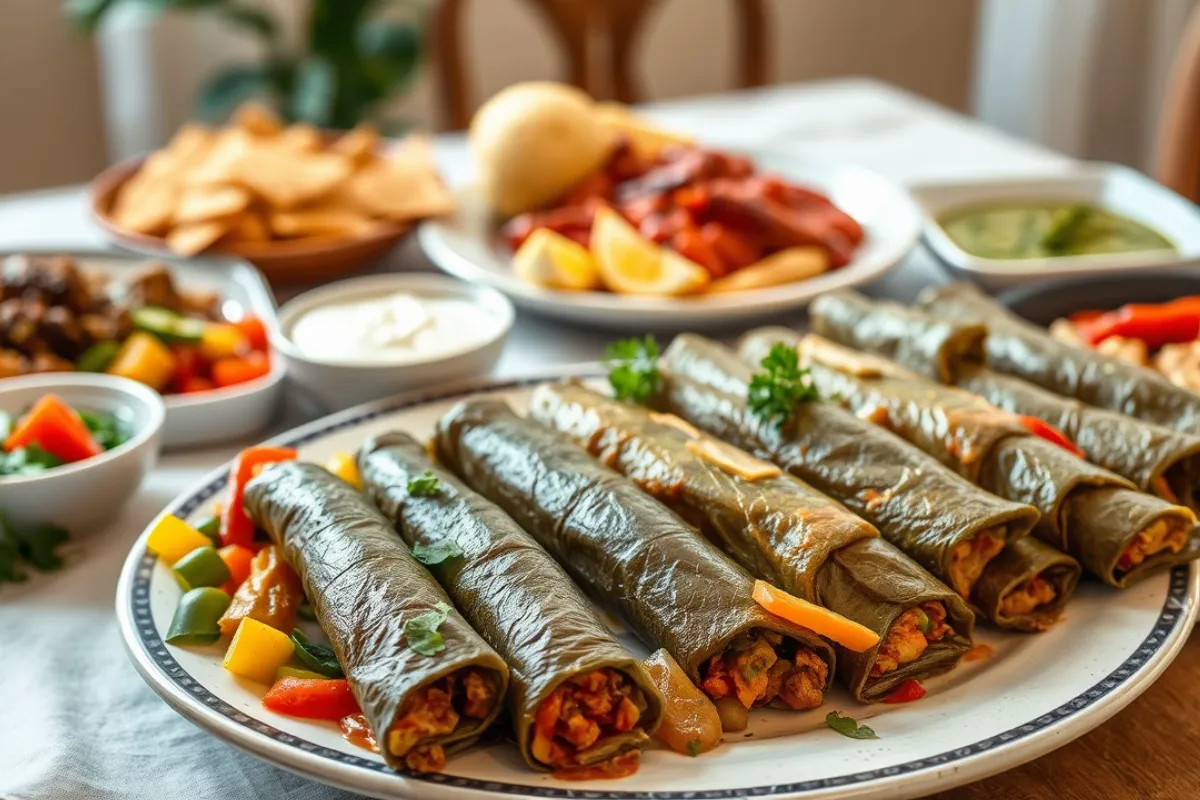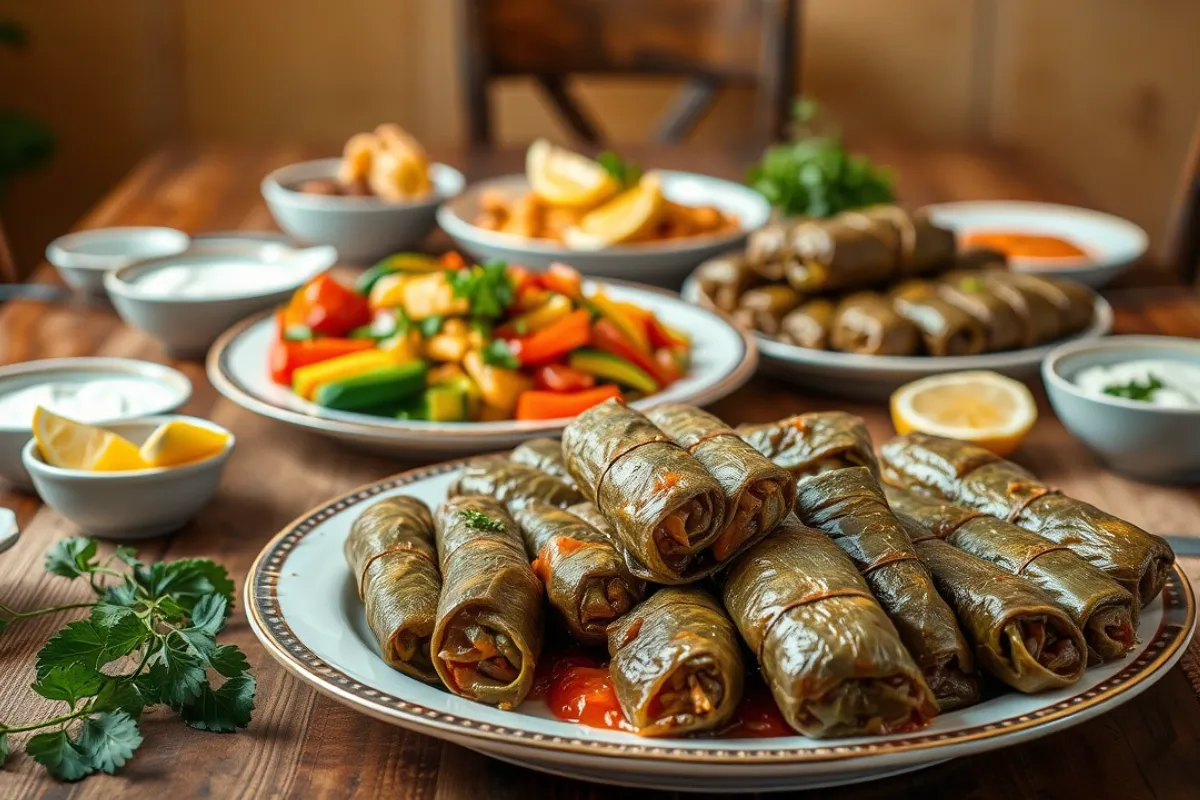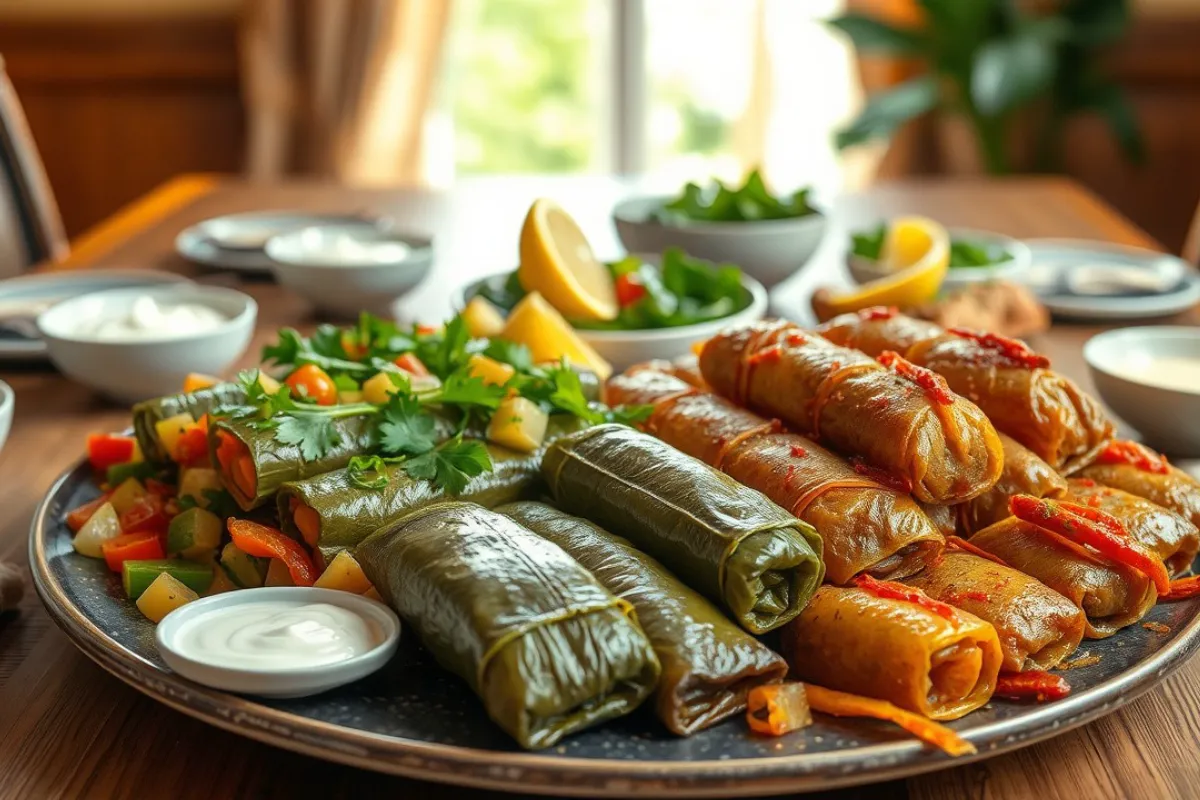Table of Contents
- Introduction
- Historical Origins of Dolma and Sarma
- What is Dolma?
- Common Ingredients Used in Dolma
- Types of Dolma
- Preparation Techniques for Dolma
- What is Sarma?
- Common Ingredients Used in Sarma
- Types of Sarma
- Preparation Techniques for Sarma
- Ingredients and Preparation Techniques
- Tips for Perfect Dolma and Sarma
- Serving and Pairing
- Cultural Significance
- Nutritional Value
- FAQs
- Conclusion
What is the Difference Between Dolma and Sarma? A Comprehensive Guide
Introduction
When diving into the diverse and flavorful world of Mediterranean and Middle Eastern cuisine, two dishes often create curiosity and confusion due to their similarities: dolma and sarma. Both of these dishes hold a special place in the culinary traditions of many cultures, and while they may seem alike at first glance, they have distinct characteristics that set them apart. This comprehensive guide will explore the differences between dolma and sarma, delving into their historical origins, ingredients, preparation methods, cultural significance, and more. By the end of this article, you will have a clear understanding of what makes each dish unique.

Historical Origins of Dolma and Sarma
The history of dolma and sarma is deeply intertwined with the Ottoman Empire, which greatly influenced the culinary traditions across a vast region spanning from the Balkans to the Middle East. The term dolma is derived from the Turkish verb dolmak, meaning “to be stuffed,” which perfectly describes the essence of the dish. Sarma, on the other hand, comes from the Turkish verb sarmak, meaning “to wrap” or “to roll.”
The origins of these dishes can be traced back to ancient times, but they became particularly popular during the Ottoman era, when they spread throughout the empire. Dolma traditionally refers to a variety of stuffed vegetables, including grape leaves, peppers, tomatoes, and zucchini, where the filling usually consists of rice, herbs, and sometimes meat. Sarma specifically refers to the technique of wrapping grape leaves or cabbage leaves around a similar filling.
These dishes have since become integral parts of the culinary traditions in countries such as Turkey, Greece, Lebanon, and the Balkans, each adding its own local twist to the recipes. For example, in Greece, dolma (often referred to as dolmades) is typically made with grape leaves, while in Turkey, dolma can include a variety of vegetables like eggplant and zucchini.
Understanding the difference between zucchini and Lebanese zucchini can be particularly insightful for those looking to explore how different types of vegetables are used in dolma and other similar dishes. This distinction is especially relevant in the preparation of these dishes, as different types of zucchini can affect the flavor and texture.
What is Dolma?
Dolma is a dish that involves hollowing out vegetables and stuffing them with a savory filling. The term dolma is often used broadly to describe stuffed vegetables, but it can also refer specifically to grape leaves stuffed with a mixture of rice, herbs, and sometimes meat.
Common Ingredients Used in Dolma
- Vegetables: The most common vegetables used in dolma include bell peppers, tomatoes, zucchini, eggplant, and grape leaves. Each vegetable brings its own unique flavor and texture to the dish.
- Rice: Rice is a staple ingredient in dolma fillings. It provides a hearty base that absorbs the flavors of the herbs and spices.
- Herbs and Spices: Fresh herbs like dill, mint, and parsley are commonly used, along with spices such as cinnamon, allspice, and black pepper.
- Meat (Optional): Ground beef, lamb, or chicken can be added to the filling, though vegetarian versions are also popular.
Types of Dolma
- Grape Leaf Dolma
This is perhaps the most well-known version of dolma, where grape leaves are used as the wrapping material. The filling typically consists of rice, pine nuts, and currants in the vegetarian version, or with a spiced meat and rice mixture. - Stuffed Peppers and Tomatoes
Bell peppers and tomatoes are hollowed out and stuffed with the rice mixture. These are particularly popular in Turkey and Greece. - Stuffed Zucchini and Eggplant
Zucchini and eggplant are hollowed out, stuffed, and then slowly cooked until tender. This version of dolma is common in Mediterranean cuisine.
For those interested in trying their hand at making dolma, learning how to prepare Mediterranean stuffed zucchini can be an excellent starting point. This dish showcases the versatility of zucchini and how it can be used to create a flavorful and satisfying meal.
Preparation Techniques for Dolma
The preparation of dolma involves several steps, each of which contributes to the final flavor and texture of the dish. Here’s a step-by-step guide:
- Preparing the Vegetables:
The first step is to select and prepare the vegetables. For stuffed grape leaves, the leaves must be blanched in boiling water to soften them. Other vegetables, like peppers, tomatoes, and zucchini, are hollowed out to make room for the filling. - Making the Filling:
The filling typically consists of rice mixed with chopped herbs, spices, and sometimes meat. The ingredients are combined in a bowl, and then a small amount of water or broth is added to help the rice cook during the steaming process. - Stuffing the Vegetables:
The prepared filling is carefully spooned into the hollowed vegetables or wrapped in the grape leaves. It’s important not to overfill the vegetables, as the rice will expand during cooking. - Cooking the Dolma:
The stuffed vegetables are arranged in a pot, with grape leaves often placed at the bottom to prevent sticking. Water or broth is added to the pot, and the dolma is cooked slowly over low heat until the vegetables are tender and the rice is fully cooked. - Serving:
Dolma can be served warm or at room temperature. It’s often accompanied by a side of yogurt or a drizzle of olive oil.
Understanding how to properly prepare and cook dolma is crucial for achieving the right balance of flavors and textures. Additionally, tips on how to keep zucchini from getting soggy when roasting can be particularly useful for those preparing zucchini-based dolma.
What is Sarma?
Sarma is closely related to dolma, but with a key difference: it involves wrapping leaves around the filling rather than stuffing the filling into a hollowed vegetable. The most common leaves used for sarma are grape leaves and cabbage leaves.
Common Ingredients Used in Sarma
- Grape or Cabbage Leaves: The primary difference between dolma and sarma is the use of leaves to encase the filling. Grape leaves are more common in Mediterranean regions, while cabbage leaves are popular in Eastern European cuisines.
- Rice: As with dolma, rice is the foundation of the filling, often mixed with herbs and spices.
- Herbs and Spices: Similar to dolma, sarma uses fresh herbs like dill and mint, with spices such as cinnamon and allspice.
- Meat (Optional): Ground meat can be added to the rice mixture, especially in non-vegetarian versions.
Types of Sarma
- Grape Leaf Sarma
This version of sarma involves wrapping a rice mixture in grape leaves. The filling can be vegetarian, often with pine nuts and currants, or include meat. - Cabbage Roll Sarma
Common in Eastern Europe, this type of sarma uses cabbage leaves to wrap a filling of rice and meat. The rolls are often cooked in a tomato-based sauce, adding a rich flavor to the dish. - Swiss Chard or Collard Green Sarma
In some regions, Swiss chard or collard greens are used instead of grape or cabbage leaves. These leafy greens add a different texture and flavor to the sarma.
Preparation Techniques for Sarma
The preparation of sarma is similar to dolma, but with the added step of wrapping the leaves around the filling. Here’s a guide to making sarma:
- Preparing the Leaves:
Grape leaves are blanched in boiling water to soften them, while cabbage leaves may need to be boiled until tender. Other leaves like Swiss chard or collard greens are also blanched to make them pliable. - Making the Filling:
The filling is prepared in the same way as for dolma, with rice, herbs, and spices combined in a bowl. Meat can be added if desired. - Wrapping the Leaves:
A small amount of filling is placed at the base of each leaf, which is then rolled tightly around the filling, tucking in the sides as you go to create a neat package. - Cooking the Sarma:
The wrapped leaves are placed seam-side down in a pot, layered tightly together. Water or broth is added, and the sarma is cooked over low heat until the filling is cooked through and the leaves are tender. - Serving:
Like dolma, sarma can be served warm or at room temperature, often with a side of yogurt or a squeeze of lemon juice.
Understanding the wrapping technique is crucial for making perfect sarma. It ensures that the filling stays inside during cooking and that each bite is a delightful combination of flavors and textures.

Ingredients and Preparation Techniques
Both dolma and sarma share similar ingredients, with regional variations influencing the specific spices and additional components. Here’s a detailed breakdown of common ingredients and preparation techniques:
- Rice: Rice is the foundation of both dolma and sarma fillings. It provides a hearty base that absorbs the flavors of the herbs and spices. Short-grain rice is often preferred because it becomes tender and slightly sticky when cooked, helping the filling to hold together.
- Herbs and Spices: Fresh herbs like dill, mint, and parsley are commonly used in both dishes, adding a burst of flavor. Spices such as cinnamon, allspice, and black pepper are also typical, providing warmth and depth to the filling.
- Vegetables: In dolma, vegetables like bell peppers, tomatoes, zucchini, and eggplant are hollowed out and stuffed. In sarma, the grape or cabbage leaves are blanched before wrapping to soften them and make them pliable.
- Meat: Optional in both dishes, ground beef, lamb, or chicken can be added to the filling to create a heartier meal. The meat is typically mixed with the rice and spices before being stuffed or wrapped.
Tips for Perfect Dolma and Sarma
- Don’t Overstuff: Whether you’re making dolma or sarma, it’s important not to overfill the vegetables or leaves. Rice expands as it cooks, so leaving a little room in each stuffed vegetable or wrapped leaf ensures the filling won’t burst out.
- Use Fresh Herbs: Fresh herbs make a significant difference in the flavor of both dolma and sarma. Dried herbs can be used in a pinch, but the vibrant flavors of fresh dill, mint, and parsley are ideal.
- Cook Slowly: Both dishes benefit from slow cooking. This allows the flavors to meld together and ensures that the rice and vegetables or leaves are cooked thoroughly.
- Layer Properly: When cooking dolma or sarma, place a layer of grape leaves, cabbage leaves, or even sliced tomatoes at the bottom of the pot. This prevents the stuffed vegetables or wrapped leaves from sticking to the pot and adds additional flavor.
For those experimenting with stuffed vegetables, understanding how to keep zucchini from getting soggy when roasting can be particularly useful. This tip is especially relevant for those preparing zucchini-based dolma.
Serving and Pairing
Traditionally, dolma and sarma are served as appetizers or as part of a mezze platter. However, they can also be enjoyed as a main course, particularly when paired with complementary sides and accompaniments.
Serving Suggestions:
- Yogurt or Tzatziki: A side of yogurt or tzatziki is a classic pairing for both dolma and sarma. The cool, creamy texture of yogurt balances the rich, savory flavors of the stuffed vegetables or wrapped leaves.
- Flatbread or Pita: Serve dolma and sarma with flatbread or pita to scoop up the filling and juices. The bread also adds a satisfying texture contrast to the tender vegetables or leaves.
- Fresh Salad: A fresh salad with cucumbers, tomatoes, and olives complements the flavors of dolma and sarma, adding a refreshing crunch to the meal.
- Lemon Wedges: A squeeze of lemon juice over dolma or sarma just before serving brightens the flavors and adds a tangy note that enhances the dish.
Cultural Significance
Dolma and sarma are more than just food; they hold significant cultural value. These dishes are often made for special occasions such as weddings, religious festivals, and family gatherings. In many cultures, the preparation of dolma or sarma is a communal activity, bringing families together in the kitchen to roll grape leaves or hollow out vegetables.
Each region has its own version of these dishes, reflecting local tastes and traditions. In Turkey, for example, dolma might be made with zucchini, while in Greece, grape leaves are more commonly used. In Eastern Europe, cabbage rolls are a traditional dish, often served during the winter months.
Some cultures, dolma and sarma are also associated with specific holidays. For example, in Greece, dolmades are often served during Lent, a period of fasting before Easter, as they can be made without meat and are thus suitable for a vegetarian diet.
These dishes are also symbolic of abundance and hospitality. The time and care required to make dolma and sarma demonstrate a commitment to providing a delicious and satisfying meal for guests, making them a popular choice for celebrations and gatherings.
Nutritional Value
Both dolma and sarma offer nutritional benefits, particularly when prepared with fresh ingredients and balanced seasonings. Here’s a look at the nutritional highlights of these dishes:
High in Fiber:
Thanks to the rice and vegetables, both dolma and sarma are high in fiber, which is essential for digestive health. Fiber helps to regulate the digestive system, keeping you full longer, and can aid in weight management.
Rich in Vitamins and Minerals:
The fresh vegetables and herbs used in dolma and sarma are rich in vitamins and minerals, including vitamin C, vitamin K, and potassium. These nutrients are vital for maintaining good health, supporting everything from immune function to bone health.
Low in Calories:
Both dishes are relatively low in calories, especially when made without meat. This makes them a healthy choice for those looking to enjoy a delicious meal without consuming too many calories.
Adaptable for Different Diets:
Dolma and sarma can be easily adapted to suit various dietary needs. For example, they can be made vegetarian or vegan by omitting the meat and using plant-based fillings. They can also be gluten-free if made with rice or other gluten-free grains.
For those interested in the health benefits of these dishes, exploring the nutritional benefits of the Mediterranean diet can provide additional insights into how these dishes fit into a healthy eating plan.
FAQs
What is the difference between dolma and sarma?
Dolma generally refers to stuffed vegetables, while sarma involves wrapping leaves around a filling.
Can dolma and sarma be made vegetarian?
Yes, both dishes can be easily adapted to vegetarian versions by using a rice and herb filling without meat.
Which is more popular, dolma or sarma?
Popularity varies by region, with dolma being more common in Turkey and the Middle East, and sarma in the Balkans and Eastern Europe.
How do you store leftovers for these dishes?
Both dishes can be stored in an airtight container in the refrigerator for up to 3 days. Reheat gently to avoid drying out.
What are some common mistakes when making dolma or sarma?
Overstuffing the vegetables or leaves can lead to the filling spilling out during cooking. It’s also important not to cook them too quickly, as slow cooking allows the flavors to meld and the rice to fully cook.
conclusion
while dolma and sarma share many similarities, they each bring their own unique flavors and textures to the table. Understanding the differences between these two beloved dishes enhances the appreciation of their cultural and culinary significance, making them even more enjoyable to prepare and eat. Whether you’re hosting a family gathering or simply exploring new recipes, dolma and sarma are sure to delight with their rich history and delicious taste.

